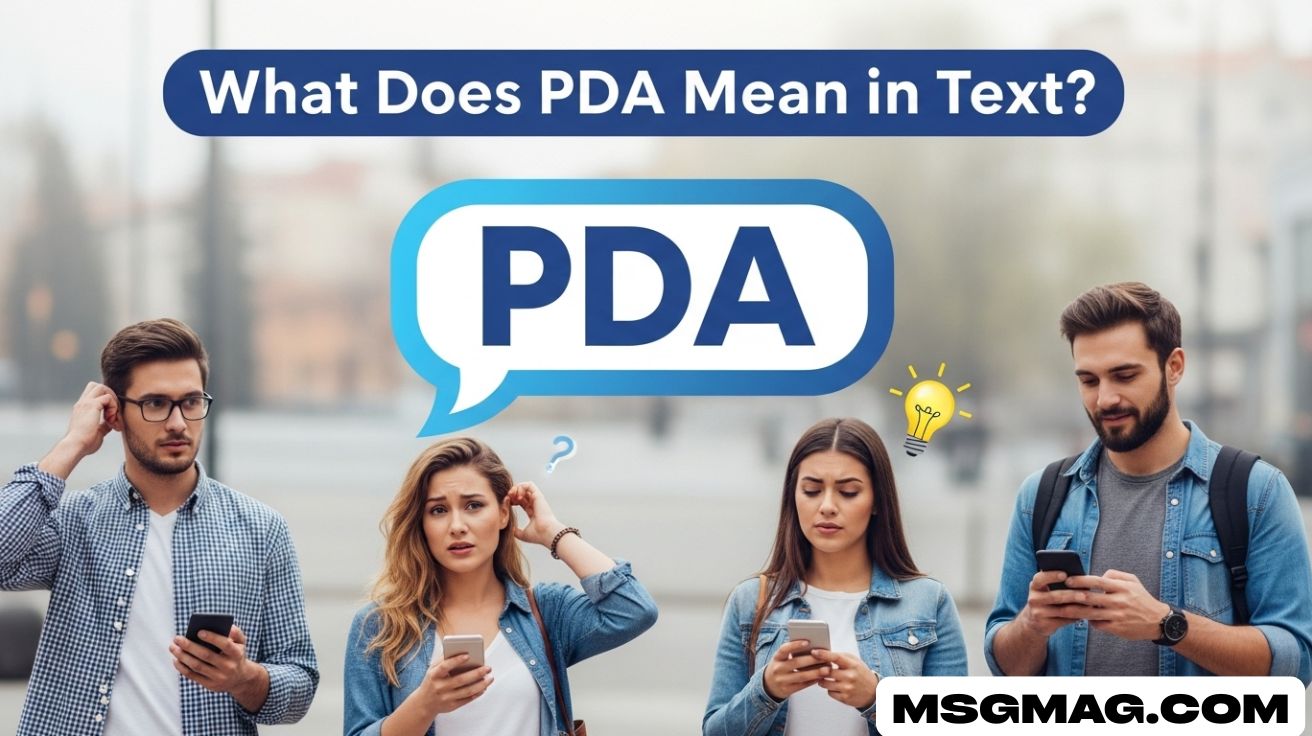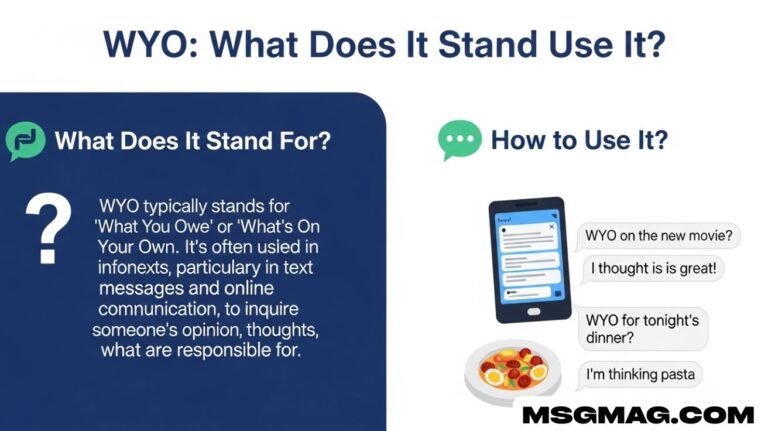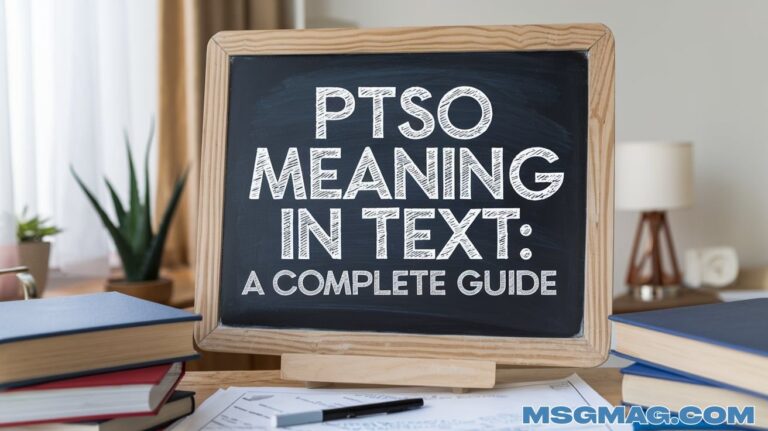What Does PDA Mean in Text? The Full Explanation
PDA mean in text stands for Public Display of Affection. It shows love or care openly in messages or chats. People use it to talk about holding hands, hugging, or kissing in public.
Have you ever seen a friend teasing a couple for too much PDA texting? Or read a chat praising cute public affection? It’s everywhere online and in texts today.
PDA in text can mean romantic gestures or even friendly hugs. It helps people share feelings and talk about social interactions. Knowing this term makes chats and social media easier to understand.
Definitions & Meaning
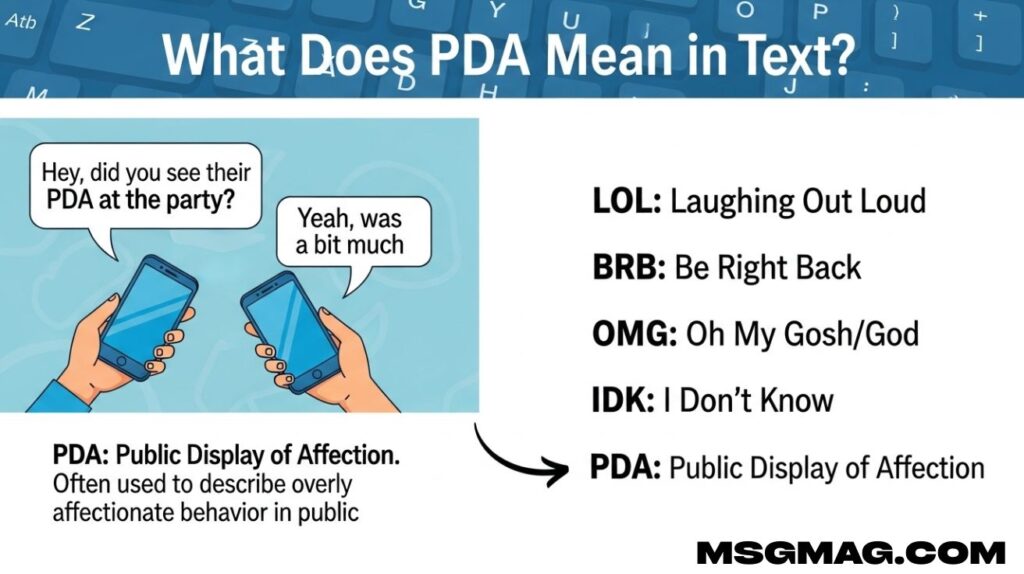
PDA stands for Public Display of Affection. In its simplest form, it refers to any action that openly shows love, care, or closeness in public spaces. These actions can range from holding hands, hugging and kissing, to gentle touches that others can notice. The key idea is that the affection is visible and meant to be seen by people around.
In texting, when someone mentions PDA in text, they are usually referring to how much affection is being shown publicly. For instance, a friend might tease a couple for sharing too much public affection or compliment them on their cute romantic gestures. While most often associated with romantic relationships, PDA can also describe family affection or friendly affection, like a hug between siblings or close friends in public. Understanding PDA texting helps decode conversations and sets boundaries for acceptable behavior in various social contexts.
Origins & History
The concept of Public Display of Affection is not new. Historically, societies have always had rules, formal or informal, about how much affection in public is acceptable. In the Victorian era, any physical touch between couples in public was heavily frowned upon, and romantic gestures outside private spaces could be considered scandalous. Over time, especially in the United States, cultural norms evolved, and public gestures of love became more widely accepted. Today, acceptable PDA varies depending on the region, social setting, and personal comfort levels.
The PDA abbreviation itself likely became popular with the rise of digital communication, especially texting and online chatting in the late 1990s and early 2000s. As messaging apps and social media platforms emerged, people needed quick ways to discuss common social topics, including social interactions and romantic gestures. Now, mentioning PDA in text is a natural part of conversations about relationships, social etiquette, and emotional expression.
Usage in Different Contexts
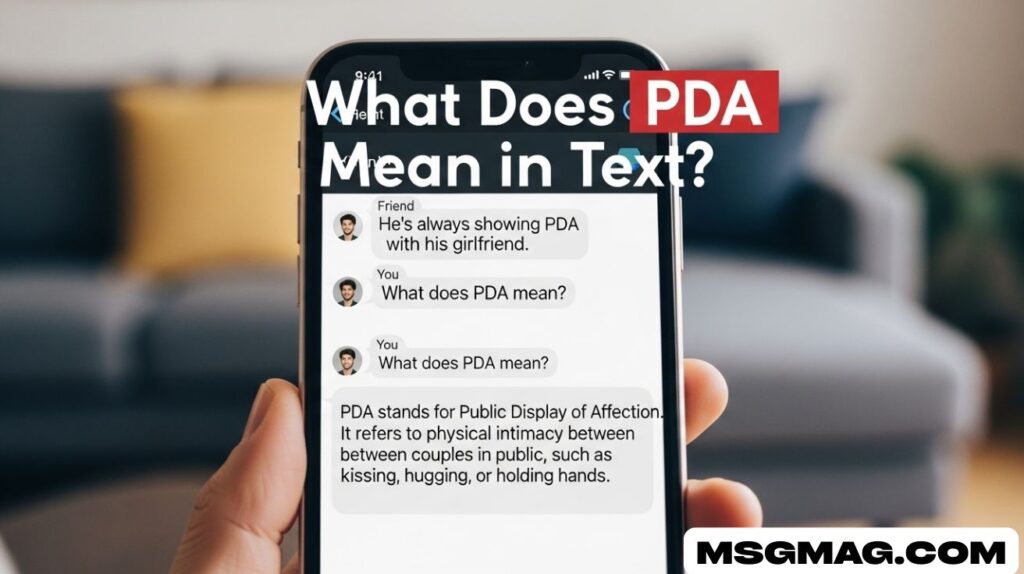
Social Media and Texting
On platforms like Instagram, Snapchat, TikTok, and WhatsApp, social media PDA is frequently highlighted. Users may post photos of couples holding hands or hugging and kissing, prompting comments such as “Aww, look at their cute PDA!” or playful jabs like “Too much PDA, please!” In texting, friends often discuss or joke about a couple’s public affection, sharing opinions about what is sweet or excessive. In this way, PDA texting serves as a shorthand for discussing romantic gestures or evaluating social norms in a light-hearted, relatable way.
Professional Settings
Workplaces in the USA generally discourage public affection between colleagues. Workplace PDA rules are in place to maintain professionalism and prevent discomfort. While a brief handshake or pat on the back is acceptable, prolonged hugging and kissing or holding hands with a romantic partner can be considered inappropriate. Many companies provide guidelines on appropriate social interactions, emphasizing that even minor acts of public gestures of love should be context-sensitive. Understanding these rules ensures that employees avoid conflicts while still acknowledging human connections.
Pop Culture
Pop culture PDA plays a significant role in shaping how society views romantic gestures. Movies, TV shows, and music often highlight public affection in both positive and comedic ways. For instance, iconic movie scenes where a couple shares a kiss on a busy street or holding hands during a dramatic moment often influence real-world behavior and expectations. Pop culture also provides a lens for understanding what is considered acceptable PDA or excessive PDA, making it easier for people to navigate their own social interactions and romantic relationships in public spaces.
Common Misunderstandings & Clarifications
A frequent PDA misunderstanding is that it only involves kissing or intense physical contact. In reality, Public Display of Affection includes subtle gestures like holding hands, a gentle touch on the shoulder, or even sitting closely in public. Another misconception is that PDA is universally accepted. In the USA, what is considered acceptable PDA varies by region and social setting. For example, a brief hug in a park is widely accepted, while more intimate romantic gestures in formal or professional settings can be frowned upon.
Some people assume that PDA is only about romantic partners, but it also applies to family affection and friendly affection. It’s important to understand that the context defines appropriateness, and cultural norms can influence what is seen as respectful or excessive. Misinterpreting these cues can lead to awkward social situations, which is why understanding PDA in text and real-life social etiquette is so valuable.
Alternatives & Synonyms
While PDA is the most widely used term, there are several other ways to describe public affection. Common alternatives include “Public Affection,” “Physical Affection in Public,” “Open Affection,” and “Couple PDA.” In casual conversation or texting, people might simply say “showing affection” or “being affectionate in public” instead of using the acronym. Using these alternatives allows for more flexible communication, especially in conversations where clarity or tone is important.
| Term | Context | Notes |
| Public Affection | General | Formal, clear, not slang |
| Physical Affection in Public | Workplace or social | Emphasizes physical acts |
| Open Affection | Casual | Friendly or romantic |
| Couple PDA | Social media | Specific to romantic relationships |
| Showing affection | Texting | Informal, versatile |
Understanding PDA in Modern Texting Culture
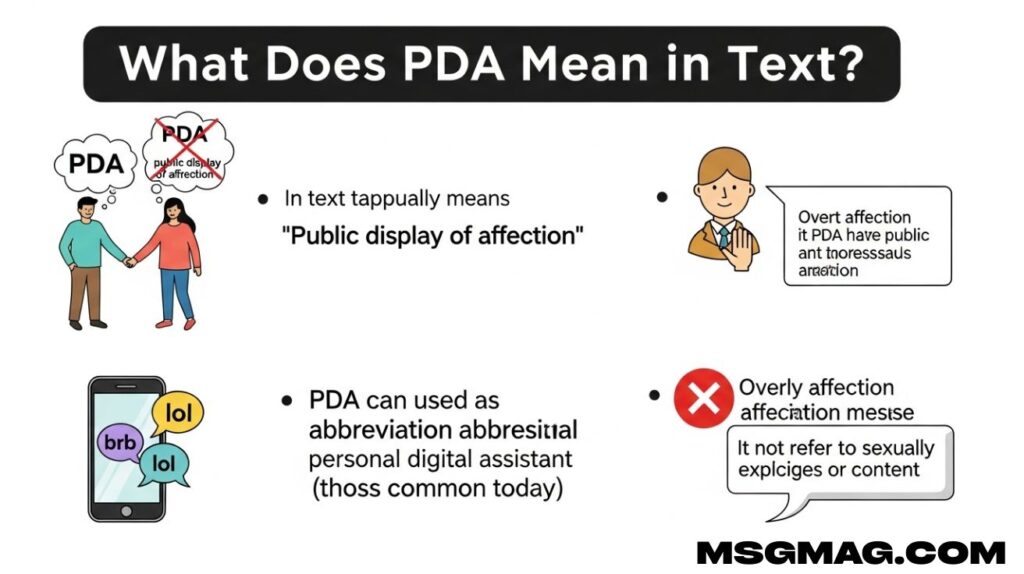
In today’s digital age, PDA in text is a common topic among friends, couples, and social media users. People often use it to discuss romantic gestures or playful public affection seen online. Understanding what PDA texting really means helps avoid confusion in conversations and ensures that messages are interpreted correctly, whether referring to holding hands, hugging, or other visible acts of love.
Texting about PDA can range from teasing comments like “Too much PDA!” to compliments on sweet couple PDA moments. It also reflects broader social interactions and cultural norms about what is acceptable in public. Knowing the context of PDA abbreviation allows people to share experiences, jokes, or opinions about affection in public without misunderstanding the intent behind the messages.
The History of Public Display of Affection
The concept of Public Display of Affection has existed for centuries. Historically, romantic gestures in public were limited by strict cultural rules. In earlier times, even a simple gesture like holding hands could be seen as inappropriate. Over time, especially in the USA, social norms evolved to accept affection in public, creating a space where couples can express their feelings openly.
The PDA abbreviation became popular with the rise of texting and social media in the 1990s and 2000s. PDA in text allowed people to quickly discuss social interactions and romantic gestures without lengthy explanations. Today, it is a part of everyday digital communication, reflecting how modern culture embraces open, visible forms of love and playful commentary about public gestures of love.
Read Also : What Does WFH Mean in Text? Quick Guide to the Acronym
How PDA is Shared on Social Media
Social media PDA is a common way couples showcase their love online. Posts showing holding hands, hugging and kissing, or affectionate captions highlight romantic gestures in public. Users comment with playful reactions, jokes, or compliments, turning private moments into visible, shareable experiences that reflect both personal relationships and broader social interactions.
Platforms like Instagram, TikTok, and Snapchat amplify PDA in text discussions. Friends might tease each other about couple PDA or praise subtle affection in public moments. Social media acts as a mirror for cultural attitudes toward public affection, helping people understand what is seen as acceptable PDA versus excessive PDA in everyday life.
PDA in Professional and Public Spaces
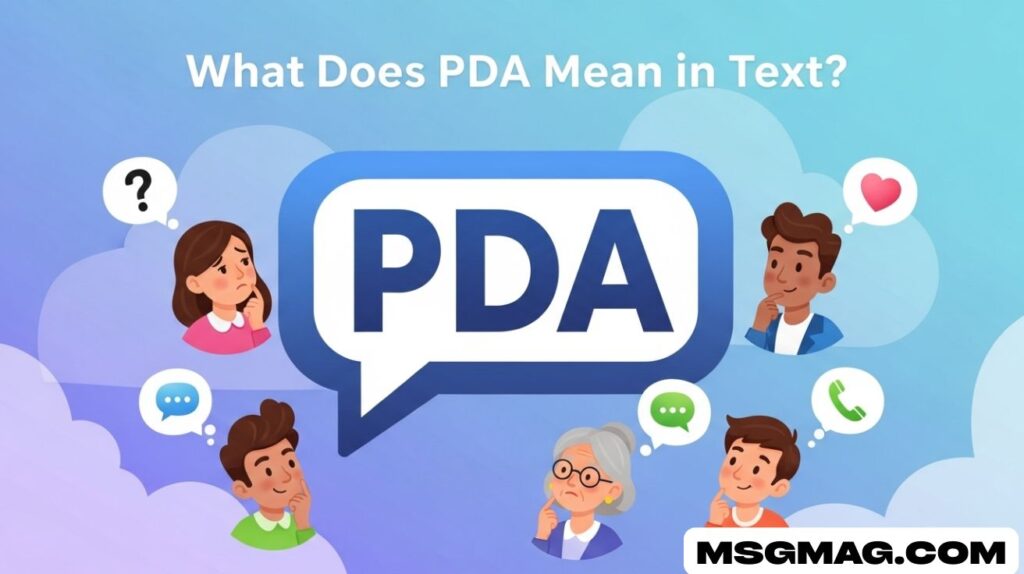
Workplace PDA rules ensure professional environments remain comfortable for everyone. In offices, visible romantic gestures such as hugging and kissing are often discouraged, while polite handshakes or friendly gestures are acceptable. Understanding public affection boundaries helps maintain professionalism and respect in social interactions at work, reducing potential misunderstandings or awkward situations.
Public spaces outside work also vary in tolerance for affection in public. Small gestures like holding hands are usually welcomed, while prolonged couple PDA may draw attention. Recognizing regional norms and cultural differences is essential for expressing romantic gestures appropriately, especially in areas where acceptable PDA is more conservative or context-sensitive.
Common PDA Misunderstandings
A frequent PDA misunderstanding is that it only involves kissing or intimate acts. In reality, Public Display of Affection includes subtle gestures like a touch on the shoulder, a hug, or holding hands. Many people confuse public gestures with excessive behavior, not realizing that friendly affection and family affection can also fall under PDA in certain contexts.
Cultural differences influence what is considered acceptable PDA. Some regions of the USA may embrace visible romantic gestures, while others prefer minimal public affection. Knowing the context and social norms prevents misunderstandings, allowing people to enjoy social interactions and romantic gestures openly without causing discomfort or appearing inappropriate.
Alternative Terms for PDA
While PDA abbreviation is common, several alternatives describe public affection. Phrases like “Public Affection,” “Open Affection,” “Physical Affection in Public,” and “Couple PDA” are often used interchangeably. These terms help convey the idea of visible love, whether in text conversations or social settings, providing clarity for both casual and formal discussions.
In texting or social media, people may use expressions like “showing affection” or “being affectionate in public” instead of PDA texting. Using these alternatives makes messages more accessible, especially for those unfamiliar with slang. They also allow discussions of romantic gestures, family affection, and friendly affection while respecting cultural norms and avoiding PDA misunderstandings.
Why Understanding PDA Matters
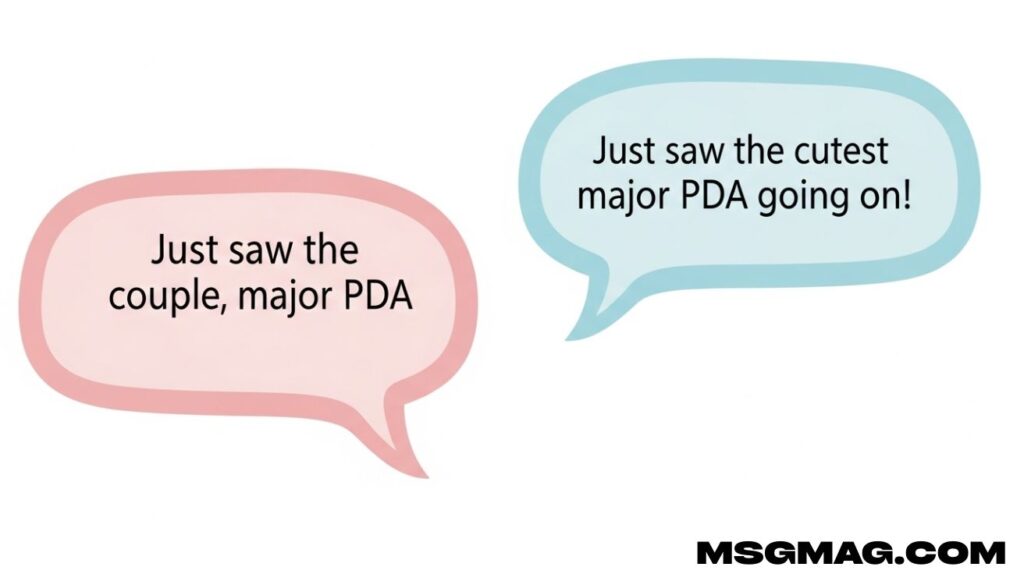
Knowing PDA meaning helps people navigate both online and real-life social interactions. It provides context for interpreting messages, social media posts, and public behavior. Understanding romantic gestures and public affection ensures individuals can communicate clearly, recognize boundaries, and respect different comfort levels in various situations.
Awareness of PDA texting also promotes respectful engagement with friends, family, and colleagues. By recognizing the difference between acceptable PDA and excessive PDA, people can avoid awkward encounters while expressing feelings openly. Mastering this understanding strengthens relationships and enhances confidence in public and digital social interactions.
FAQs
What does PDA mean in chat?
PDA in chat means Public Display of Affection, referring to openly showing love or affection in messages or conversations.
What does PDA mean in relationship terms?
In relationships, PDA refers to visible romantic gestures, like holding hands, hugging, or kissing, shown publicly.
What is PDA in Gen Z slang?
Gen Z uses PDA to describe any public romantic or affectionate behavior, often joking or teasing about it online.
What does THB mean in texting?
THB in texting means To Be Honest, used to share a candid or truthful opinion.
Conclusion
Understanding PDA meaning in text and in everyday life helps people navigate social interactions and respect personal boundaries. Public Display of Affection includes acts like holding hands, hugging and kissing, and other romantic gestures visible to others. While most commonly linked to romantic relationships, it can also describe family affection and friendly affection. Acceptance of PDA varies across cultural and regional contexts in the USA, and knowing these norms helps prevent awkward or inappropriate situations.
Whether in social media PDA, workplace PDA rules, or everyday encounters, being aware of Public Display of Affection encourages respectful communication and enhances understanding of social etiquette. By grasping the meaning, history, and usage of PDA in text, you can confidently interpret messages, comment on posts, and participate in conversations without confusion. Next time you see PDA pop up in a chat or post, you’ll know exactly what it means and why it matters.

